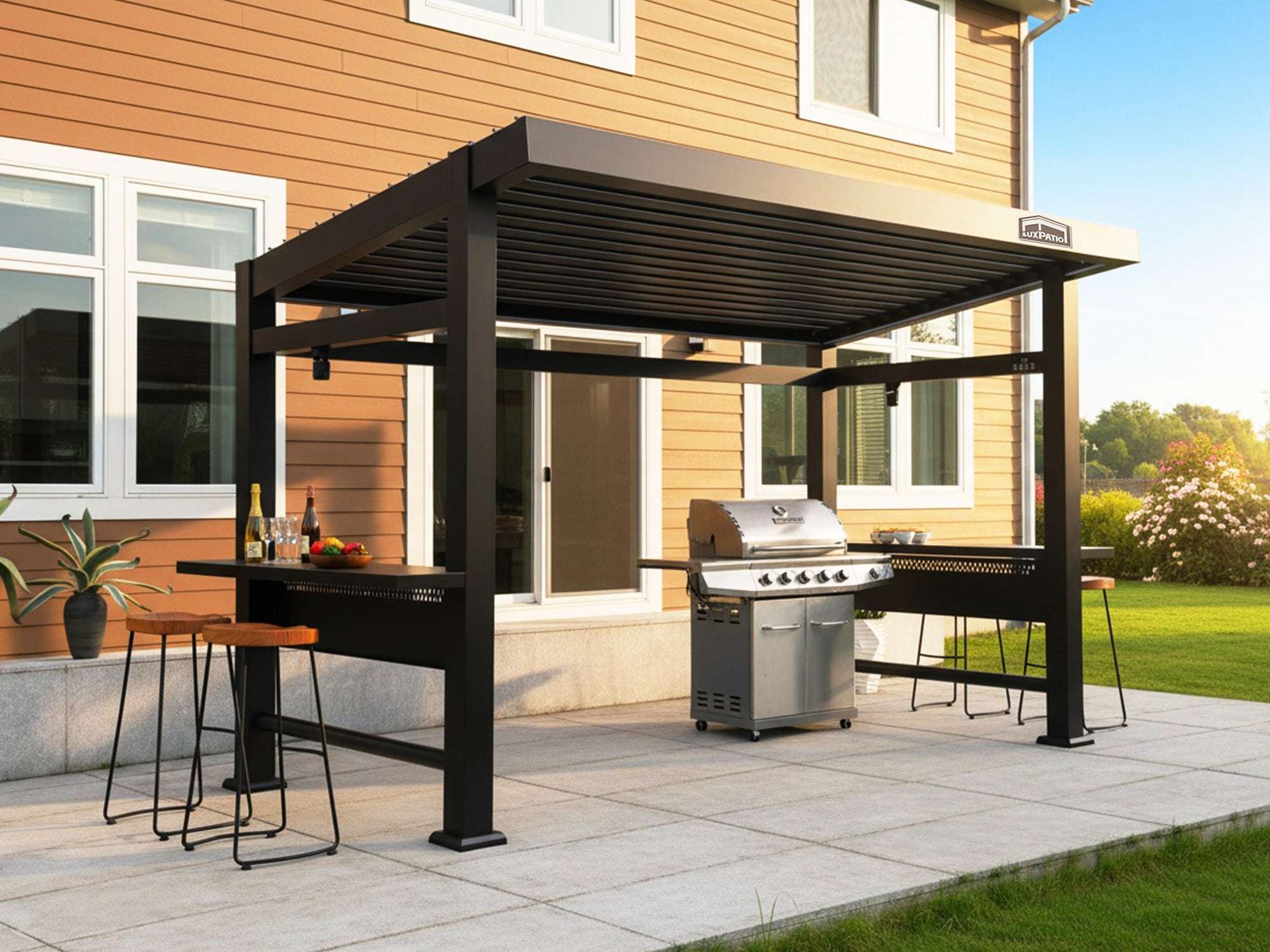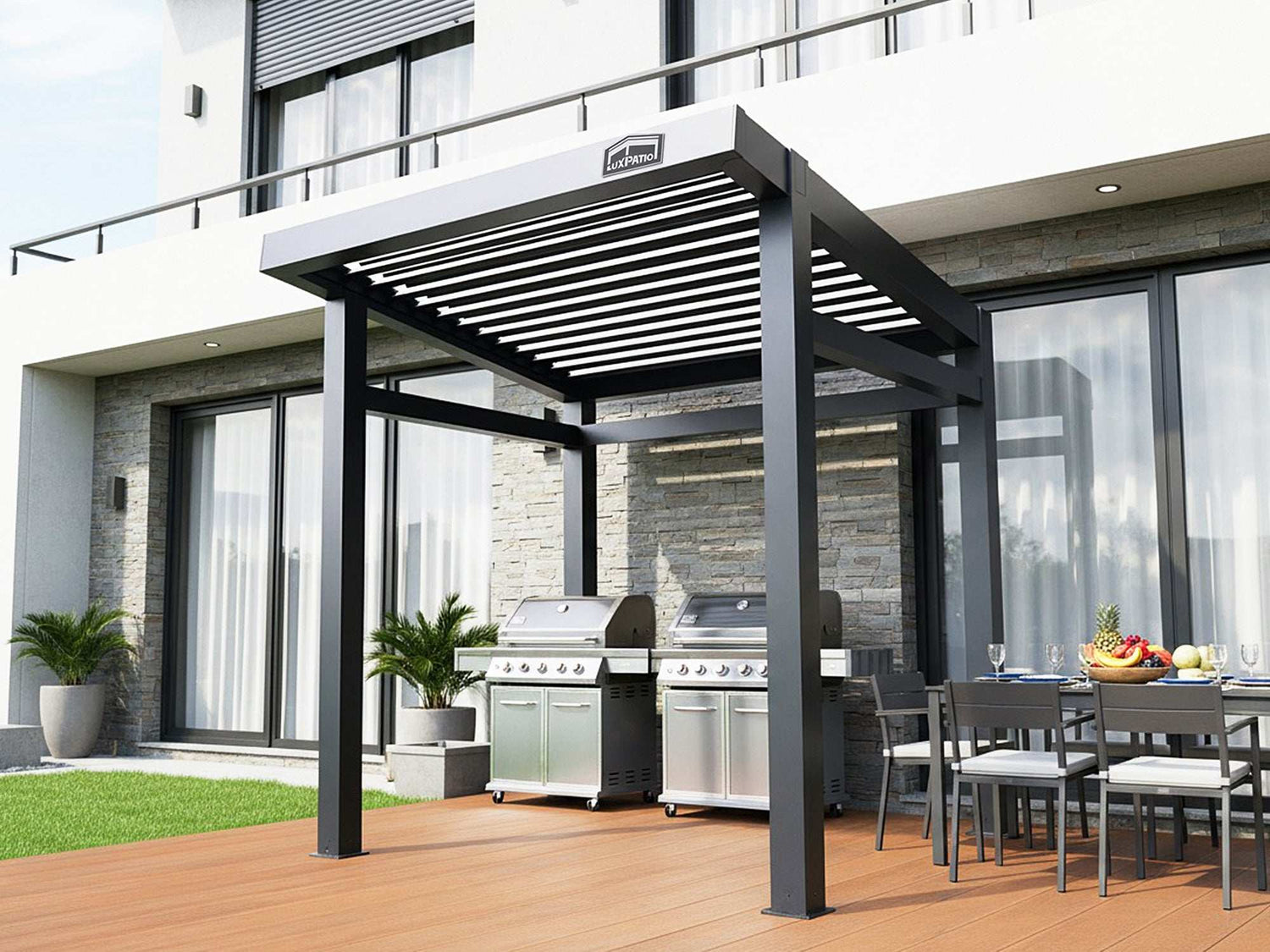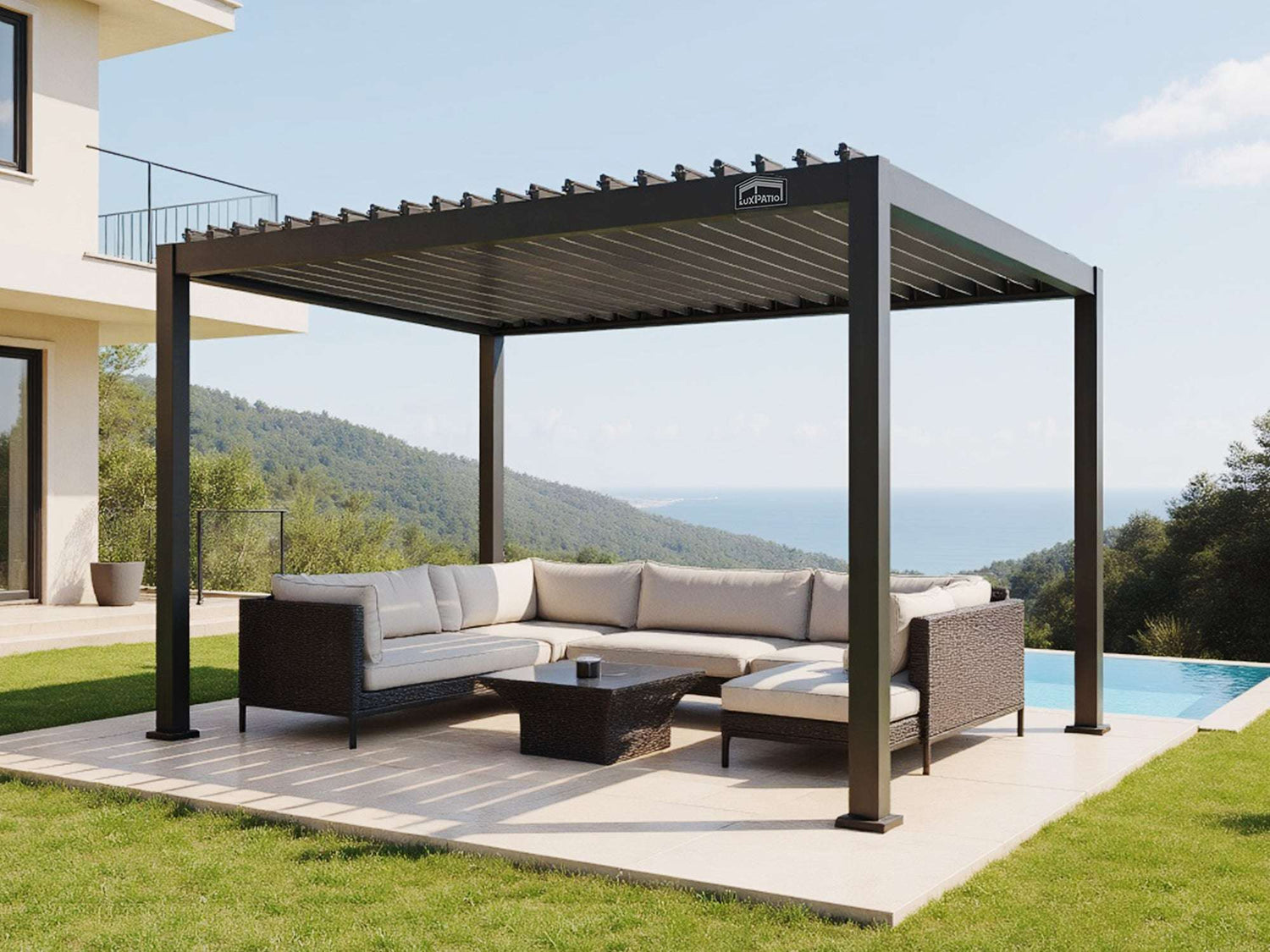Nothing upgrades a pool deck faster than a well-planned aluminum pergola. The right structure cools harsh sun, channels rain away from seating, and keeps its finish through chlorine, salt, and year-round humidity. This guide walks through material choice, adaptive shade, safety, layout, and finishing details so your space looks polished and works smoothly.
Aluminum Pergola vs Wood/Steel: The Poolside Advantage
A pool environment never rests. Splash zones, chemical drift, and strong UV push materials to their limits. An aluminum pergola handles that pressure with calm predictability because the metal resists corrosion and the finish stays stable in the sun and spray. Care is simple. A rinse brings back the original look without sanding, staining, or sealing cycles. That leaves weekends for swimming instead of maintenance chores.
Wood and plain painted steel tell a different story by the water. Wood swells and warps as it absorbs moisture, coatings fade quickly, and the calendar fills with upkeep. Cut edges on painted steel invite rust that creeps under the coating and telegraphs as streaks at fasteners. Over time, the surface loses uniformity even with touch-ups.
Quick Comparison for Poolside Use
| Material | Poolside Durability | Maintenance | Visual Consistency |
| Aluminum | High | Very Low | Consistent finish |
| Wood | Medium to Low | High | Color shifts over time |
| Plain Steel | Low | High | Risk of rust streaks |
If the goal is a reliable, long-lived structure with minimal attention, an aluminum pergola fits that brief and keeps a refined profile around the pool.

Louvered Roof Pergola: Smart Shade & Rain Diversion All Day
Sun angles move from breakfast to sunset. A louvered roof pergola follows that rhythm with a quiet tilt of the slats. Set a tight angle at noon to blunt glare over loungers, then open slightly later in the day for warmth and sky. That control turns shade into a dial instead of an on-off switch and delivers steady pergola shade without darkening the whole deck.
Showers arrive without warning in warm months. Close the louvers, and water is guided into concealed gutters, then routed through internal channels inside the post to a discreet exit point. Seating stays usable while the storm passes. It is a practical shield rather than a sealed roof, and it protects cushions, side tables, and small speakers from the quick downpour that would otherwise end the gathering.
If you prefer manual simplicity, a louvered pergola with a crank mechanism still gives precise angles with little effort. Motorized control adds convenience for frequent adjustments and lets you fine-tune light levels for reading, dining, or an afternoon nap.
Poolside Pergola Safety: Anchoring, GFCI Power & Clear Walkways
Safety choices should feel invisible day to day and absolute when the wind picks up. Anchoring, electrical planning, and circulation paths deserve the same care you would give to the pool shell itself.
Anchoring starts with a solid concrete base. Set each post on a concrete slab or engineered footings and use corrosion-resistant anchors sized for local wind conditions. Bring every post plumb before tightening hardware so beams and louvers assemble square and the frame resists racking over time. That accuracy pays off each time the roof opens and closes.
Electrical service needs respect near water. GFCI protection at the circuit or outlet provides the safety net, and fixtures should carry listings for damp or wet locations. A licensed electrician routes conduit cleanly, bonds metal components when required, and documents compliance so the system remains safe during daily use. Plan switching where it can be reached from dry ground, and keep receptacles clear of splash zones.
Traffic lines matter on busy weekends. Keep the path from the house to the pool steps open and position columns where they frame views rather than block them. Choose slip-aware deck textures under the canopy and aim lighting across the walking surface to help depth perception after dark.
Safety Checklist
- Confirm concrete slab or engineered footings and corrosion-resistant anchors
- Verify posts are square and plumb before final tightening
- Use GFCI protection and wet-rated fixtures installed by a licensed electrician
- Keep main paths clear to steps, ladders, and the shallow end
- Aim for evening lighting to support safe movement without glare
Layout That Works: Sun Path, Privacy Zones & Entertainment Flow
A pool deck hosts reading, dining, supervising kids, and weekend parties, often in the same afternoon. Zoning makes the area behave like an outdoor room instead of scattered furniture. Create a quiet retreat at the far edge with two chaises and a side table for books and drinks. Place a compact dining nook close to the kitchen door for quick service. Build a conversation cluster under the central bay of the pergola that faces the water so guests feel connected to the pool even when they are dry.
Sun mapping elevates comfort. Note where the sun falls at mid-morning, early afternoon, and late afternoon. Align louver blades so their closed position blocks the harshest period for your seating. Many patios benefit from east-west blade orientation for tight midday control. North-south alignment can favor shoulder hours. Your outdoor pergola becomes a responsive canopy tuned to your exact deck.
Leave breathing room. Maintain about thirty-six inches of clearance around chair arms and table edges so kids can loop the deck without clipping corners. If the pergola sits near a shallow-end ladder, offset one column to prevent a bottleneck where wet feet and towels converge.

Finishing Touches: LED, Fans, Curtains & Night Ambience
Lighting shapes the mood after sunset and makes the water look magical. Warm LEDs around 2700–3000K flatter faces and soften pool reflections. Aim beams along rafters to avoid glare and layer a gentle ambient glow with a few accents on planters or a feature wall. The look reads as hospitality rather than task lighting.
Air movement matters on humid evenings. A quiet outdoor-rated fan centered over seating keeps air fresh and discourages bugs. Set the speed low enough that napkins stay put on the dining table. If you wire for a second fan later, place a junction above the dining zone now so the upgrade does not disturb finished surfaces.
Textiles and planting finish the picture. Outdoor curtains filter late light and add privacy from neighboring lots. Solution-dyed fabrics on cushions and rugs hold color in full sun and shed water quickly, which means faster turnaround after swim time. Tall planters at the posts give structure and help the pergola read as an open-air room rather than a freestanding frame.
Choose an Aluminum Louvered Pergola That Fits Your Pool & Routine
A pool deck works best when form and function move together. An aluminum pergola gives a durable foundation that cleans easily and keeps a crisp profile under hard sun and regular splashes. Add the control of a louvered roof pergola for shade that follows the day and for rain routing that keeps seating ready when clouds pass. Anchor to concrete, wire with GFCI-protected circuits, and keep walkways open so the space feels effortless in daily life. Once those fundamentals stand, lighting, fans, and soft finishes deliver the atmosphere that brings people outside and keeps them there.

FAQs
Q1. Do I need a permit or HOA approval for a poolside pergola?
Many jurisdictions require zoning and electrical permits; height, setbacks, and proximity to the pool are common checks. HOAs often review color and placement. Submit drawings, footing details, electrical plan, and drainage notes; approvals typically precede delivery, scheduling, and installation.
Q2. How do wind and snow loads factor into a louvered roof pergola?
Ask for stamped engineering showing design wind speed and roof snow load per local code. In snow events, leave louvers open to avoid accumulation; in high winds, use a wind sensor and lockout. Verify anchor capacity and fastener corrosion rating.
Q3. Can I integrate controls with a smart home platform?
Many motors accept wall switches, remotes, and app control via low-voltage drivers. Add rain and wind sensors for automatic close and protection. Scenes can coordinate lighting, fan speeds, and louver angles; confirm voltage, amperage, and control protocol compatibility before installation.
Q4. Can a pergola be anchored on pavers?
Do not fasten only to pavers or sand. Core through to concrete piers or pour isolated footings below the paver bed, then re-set pavers around posts. Verify utility locations, pool plumbing, and drainage routes before drilling to prevent costly surprises.
Q5. What cleaning and maintenance schedule should I follow?
Rinse surfaces monthly, weekly in coastal or saltwater-pool settings. Use pH-neutral soap; avoid harsh acids and undiluted bleach. Clear internal gutters and down-post drains each season. Inspect anchors, bolts, and louver pivots annually; lubricate moving parts with dry PTFE lubricant.










